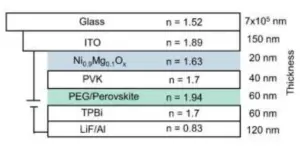The electro-optical and mechanical properties of Perovskite Light Emitting Diodes (PeLEDs) would seem to make them well suited to be the technological basis of next generation electronic displays. Desirable properties include having a narrow emission spectra, wide color tunability and a low fabrication cost. On top of all that, they are well suited for use in flexible devices. One significant drawback regarding PeLEDs is, however, that they cannot currently match the efficiency of commercially available OLEDs.
Addressing this efficiency issue was the focus of research undertaken by a team headed by Wenhao Bai of the Fujian Key Laboratory of Surface and Interface Engineering for High Performance Materials within the College of Materials at Xiamen University (Xiamen, China). To start, here are a few words of background information on PeLEDs.
In PeLED devices, the hole injection layer is typically a material called poly(3,4-ethylenedioxythiophene):poly(styrenesulfonate) or PEDOT:PSS. The hole transport layer is typically a material called poly(9-vinylcarbazole). There is an energy level mismatch between these two layers and this leads to poor hole injection. This, in turn, leads to charge carrier accumulation at the interface and a large leakage current. The mismatch in energy levels is illustrated in the figure below.

A separate issue effecting the performance of PeLEDs is that there is a large refractive index difference between the PEDOT:PSS injection layer and the perovskite emissive layer. As a consequence, the critical angle becomes smaller and more photons are trapped within these layers. The result is the outcoupling of less light and a reduction in device efficiency. If that was not enough problems, PEDOT:PSS also suffers from acidity, hygroscopicity, poor stability and high cost.
The good news is that there is an alternative to PEDOT:PSS. NiOx-based hole injection layers show higher stability and are less expensive to fabricate. In addition, they also provide tunable energy levels and an adjustable refractive index. All of these properties contribute to the suppression of leakage current and emissive photon loss.
Unfortunately, up to now, there has been little investigation of how NiOx-based hole injection layers affect charge carrier transport and the near field light field of devices. Obtaining a better understanding of this matter is a more specific statement of the research undertaken by the team. A recent article by the team reporting results of their efforts is entitled “Perovskite Light-Emitting Diodes with an External Quantum Efficiency Exceeding 30%.” It was published in Advanced Materials, May 2023.
Paraphrasing this article in describing their latest work, the team determined the relationship between the composition of the Ni1-yMgyOx-based hole injection layers, the energy levels and hole carrier mobility. Additionally, the team’s research showed that a polyethylene glycol layer sandwiched between the hole injection layer and the perovskite emission layer could be used to tailor the band structure of the perovskites and significantly increases the critical angle at the interface.
Based on this understanding, the team fabricated prototype devices utilizing the new configuration. The results were that optimized PeLED devices exhibited reduced electron leakage and a high light outcoupling efficiency. More specifically, that green PeLEDs at 530 nm exhibited a maximum external quantum efficiency of 30.84% at a luminance of 6514 cd/m2. This performance surpasses that of previously reported PeLEDs and is comparable to commercial OLEDs.
The general conclusion of this research as stated by the researchers in their article is that “electron leakage and poor outcoupling efficiency issues in NiOx-based PeLEDs can be substantially solved by regulating the charge carrier transport and the local area light field. Balanced charge carrier injection is mainly achieved by tailoring the composition of Ni1-yMgyOx hole injection layers to increase the hole mobility, while the addition of the polyethylene glycol layer between the hole transport layers and the perovskite emission layers blocks electron leakage.”
Stated more succinctly “This work provides an interesting idea to construct super high efficiency PeLEDs by balancing the electron-hole recombination and enhancing the light outcoupling.”
Reference
Bai, W., Xuan, T., Zhao, H., Dong, H., Cheng, X., Wang, L., & Xie, R.-J. (2023). Perovskite light-emitting diodes with an external quantum efficiency exceeding 30. Advanced Materials (Deerfield Beach, Fla.), e2302283. https://doi.org/10.1002/adma.202302283

